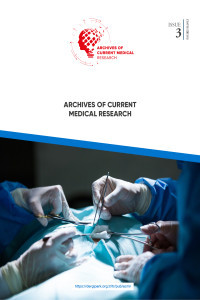Use of Vitamin, Mineral and Supporting Products in Children in Adana
Use of Vitamin, Mineral and Supporting Products in Children in Adana
Iron Vitamin D, Supportive Product, Children, Prophylaxis.,
___
- 1. Karakurt N, Terzi Ö. Prevalence of Anemia Among Children in a Single University Hospital. Journal of Dr Behcet Uz Children’s Hospital. 2019;9(2):155-9.
- 2. Gedikoğlu G, Ağaoğlu L. Kan hastalıkları. İçinde: Neyzi O, Ertuğrul T (eds). Pediatri Cilt 2 (İkinci Baskı). İzmir: Nobel Tıp Kitapevleri. 1993:347-363.
- 3. Hatun Ş, Bereket A, Çalıkoğlu AS, Özkan B. Vitamin D deficiency and nutritional rickets today. Çocuk Sağlığı ve Hastalıkları Dergisi. 2003;46:224-41.
- 4. Che CT, George V, Ijinu TP, Pushpangadan P, Andrae-Marobela K. Chapter 2 - Traditional Medicine. In: Badal S, Delgoda R, editors. Pharmacognosy. Boston: Academic Press; 2017. p. 15-30.
- 5. Committee on Herbal Medicinal Products (HMPC). Reflection paper on the necessity of initiatives to stimulate the conduct of clinical studies with herbal medicinal products in the paediatric population. 2009. Available at http://www.ema.europa.eu/docs/en_GB/ document_library/Scientific_guideline/2012/02/WC500123488.pdf Accessed September 20, 2020
- 6. Faydaoğlu E, Sürücüoğlu M. History of the Use of Medical and Aromatic Plants and their Economic Importance. Kastamonu Univ., Journal of Forestry Faculty. 2011;11(1):52-67.
- 7. Di Lorenzo C, Ceschi A, Kupferschmidt H, Lüde S, De Souza Nascimento E, Dos Santos A, et al. Adverse effects of plant food supplements and botanical preparations: a systematic review with critical evaluation of causality. Br J Clin Pharmacol. 2015;79(4):578-92.
- 8. Specker BL, Ho ML, Oestreich A, Yin TA, Shui QM, Chen XC, et al. Prospective study of vitamin D supplementation and rickets in China. J Pediatr. 1992;120(5):733-9.
- 9. WHO. Guideline: intermittent iron supplementation in preschool and school-age children. Geneva: World Health Organization; 2011. Avaliable at: http://apps .who.int/iris /bitstream/10665 /44648/1/9789241502009_eng.pdf. Accessed: September 26, 2020
- 10. T.C. Sağlık Bakanlığı Ana Çocuk Sağlıgı ve Aile Planlaması Genel Müdürlüğü. Emzirmenin korunması, özendirilmesi, desteklenmesi ile demir yetersizligi anemisinin önlenmesi ve kontrolü. Ankara, 2004: p. 4-8.
- 11. Savaş Göker F. Çocuk polikliniğine müracaat eden 3-36 ay çocuklarda nutrisyonel rikets sıklığı ve bulguların yorumu. Dr. Sadi Konuk Bakırköy Eğitim Araştırma Hastanesi. Uzmanlık Tezi. İstanbul 2006.
- 12. Pehlivan İ, Hatun S, Aydogan M. Ülkemizdeki çocuk hekimlerinin D vitamini suplemantasyonu ve rikets tedavisi konusundaki tutumları. 45. Milli Pediatri Kongresi Kitabı; Erzurum 2001.
- 13. Vatandaş N, Atay G, Tarcan A. Iron prophylaxis and anemia during the first year of life. Çocuk Sağlığı ve Hastalıkları Dergisi. 2007;50:12-5.
- 14. Yalçın SS, Tezel B, Yurdakök K, Pekcan G, Ozbaş S, Köksal E, et al. A community-based iron supplementation program, “Iron-Like Turkey”, and the following prevalence of anemia among infants aged 12-23 months. Turk J Pediatr. 2013;55(1):16-28.
- 15. Çullas-İlarslan NE, Günay F, İleri DT, Elhan AH, Ertem M, Arsan S. Investigation of the frequency of iron insufficiency among infants in a population in which routine iron supplementation is implemented. Turk J Pediatr. 2018;60(1):22-31.
- 16. Hilkay Karapınar T, Bildik O, Aydın Köker S, Töret E, Oymak Y, Ay Y, et al. The Evaluation of Taking Iron Supplements in Children Aged 6 Months-2 Years. J Pediatr Res. 2017;4(3):156-9.
- 17. Eisenberg DM, Davis RB, Ettner SL, Appel S, Wilkey S, Van Rompay M, et al. Trends in alternative medicine use in the United States, 1990- 1997: results of a follow-up national survey. Jama. 1998; 280(18):1569- 75.
- 18. Nwaiwu O, Oyelade OB. Traditional herbal medicines used in neonates and infants less than six months old in Lagos Nigeria. Niger J Paed. 2016;43(1):40-45.
- 19. Jean D, Cyr C. Use of complementary and alternative medicine in a general pediatric clinic. Pediatrics. 2007;120(1):e138-41.
- 20. Lim A, Cranswick N, Skull S, South M. Survey of complementary andalternative medicine use at a tertiary children’s hospital. J Paediatr Child Health. 2005;41(8):424-7.
- 21. Zhang Y, Fein EB, Fein SB. Feeding of dietary botanical supplements and teas to infants in the United States. Pediatrics. 2011;127(6):1060-6.
- 22. Asase A, Kadera ML. Herbal medicines for child healthcare from Ghana. J. Herb. Med. 2014;4(1):24–36.
- 23. Kraft K. Clinical trials on herbal remedies in children: a systematic review. Integr Med Res. 2015;4(1):9.
- Yayın Aralığı: Yılda 3 Sayı
- Başlangıç: 2020
- Yayıncı: 14 Mart Tıbbiyeliler Derneği
A Rare Clinical Presentation Caused by Atrial Myxoma: Right Heart Failure
Ferhat DİNDAŞ, İdris Buğra CERİK, Emin KOYUN, Okan Onur TURGUT
Are Patients With Diabetes Mellitus at Increased Risk of COVID-19 Infection?
Mehmet SÖZEN, Fatma ÇÖLKESEN, Şevket ARSLAN, Fatih ÇÖLKESEN, Melia KARAKÖSE, İbrahim ERAYMAN, Soner DEMİRBAŞ, Turgut TEKE
Virology, Immunity and Vaccine Development of SARS-CoV-2
Sidre ERGANİŞ, Gülendam BOZDAYI
Ali YÜCE, Niyazi İĞDE, Tahsin Olgun BAYRAKTAR, Mustafa YERLİ, Ali Çağrı TEKİN, Mehmet Kürşat BAYRAKTAR, Hakan GÜRBÜZ
Use of Vitamin, Mineral and Supporting Products in Children in Adana
Adnan BARUTÇU, Betül CANSEVER AKAY, Nurdan EVLİYAOĞLU, Eray AKAY
Suzuki Frame Results in the Treatment of Comminuted Phalanx Fractures
Mehmet Cenk TURGUT, Serdar TOY
Dilara Nur ŞENGÜN, Gülşah DEMİRCİ, İnci Rana KARACA
Real Life Data for Glecaprevir/Pibrentasvir: A Single-Center Study
Fatma ÇÖLKESEN, Arzu TARAKÇI, Fatma KACAR, Esma EROĞLU, Şule ÖZDEMİR ARMAĞAN
Phytocontact Dermatitis Due to Ranunculus Kotschyi Boiss : Adverse Effect for Artralgia Treatment
Gültekin KADI, Muhammed Enes DURAK, Begüm ÖKTEM, Ahmet DEMİRCAN, Ayfer KELEŞ
